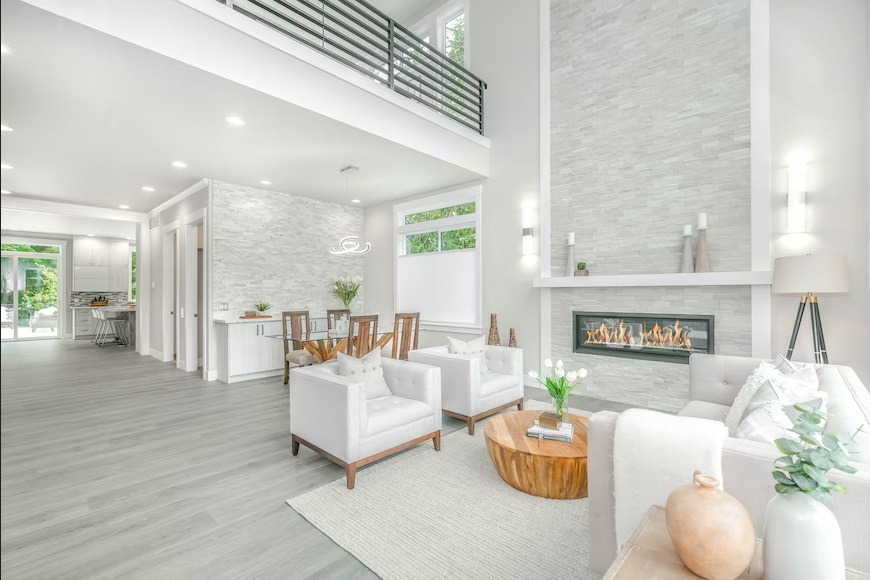While suburban architecture is slow to change, interior features are continually evolving. Home builders around the nation are investing heavily in innovative technology that provides convenience and safety, knowing what drives the market. They understand, above all, that today’s new homes must reflect the needs of modern families.
Interior design paves the road for innovative technology in concert with this development. It also caters to evolving and dynamic urban lifestyles. Integrating numerous features, home builders are changing the standards of American households, with emphasis on utility and convenience.
The list below helps families learn about automation options and gives insight into their reliability. Most of these features are on their way to becoming mandatory nationwide, especially in states with harsh climates and changing weather. If we were to observe even the most affordable new homes across upcoming communities in the Midwest, we would quickly notice the prevalence of integrated technology or ‘smart features’ in homes. For example, these Minnesota homes integrate innovative features in single-story suburban homes with little over 1,000 square feet, even in the most affordable models.
Air purification systems
A decade ago, people who cared about air pollution were considered fringe. Nowadays, however, most of us are aware of the adverse health effects caused by high concentrations of particulate matter. Faced with grim statistics, we are more inclined to invest in systems that purify ambient air, especially in homes with young children, the elderly, and people with compromised immunity.
At the bare minimum, quality purification systems should include HEPA filters, with an optional addition of activated carbon protection. The United States Environmental Protection Agency sets the annual PM2.5 standard at 15 μg/m3. Similarly, states should work hard to limit annual PM10 concentrations to 50 μg/m3.
Fiber internet connection
Given the era in which we live, the speed of our internet connection is detrimental to productive work, seamless entertainment, and reliable communication.
Compared to others, fiber optics is the ideal technology for securing a super-fast signal that is more resilient to weather conditions. Additionally, fiber infrastructure can match upload and download speed, allowing families to enjoy live streaming, VR gaming, and immersive meetings. Luckily, more than 40% of Americans have access to fiber internet.
Programmable thermostats
In many US states, seasons bring a dramatic temperature change. Those who live there are bound to struggle with manual settings as they continually adjust their systems for cooling and heating.
However, with programmable thermostats, families can enjoy more convenience and save on their utility bills. For states like Minnesota and other parts of the Midwest, these programmable thermostats can remember up to several programs that change quickly with the click of a button. This innovative technology often allows homeowners to adjust their ambient temperature via smartphone apps that function outside the property.
USB compatible outlets
As we become progressively dependent on smart gadgets and mobile devices, we expect home builders to make things more convenient. For this reason, many companies integrate USB-compatible outlets, which are located around the living room and over the kitchen counter.
According to Statista, the average American household owns more than five devices that rely on USB charging, which makes charging infrastructure increasingly important. For more fascinating tidbits about American homes, you can read our Interesting Facts About the American Home.
Wi-Fi-enabled garage door opener
Families benefit from convenience and security when doors and locks connect seamlessly with the smartphone. For this reason, installing a Wi-Fi feature on your garage door will ensure peace of mind. Additionally, it will allow easy access to your home without leaving the vehicle.
In many situations, this convenience can minimize distractions and keep you safer while exiting the driveway. Similarly, for people who live in states with freezing winters and frequent pouring rain, this feature would eliminate a lot of frustration.
Smart devices that make their way into American households
Looking at the list of popular integrations, smart speakers sit at the top, with 35% of Americans over twelve owning a model in their homes. Interestingly, these devices are used more frequently as the need for voice interaction grows yearly. Americans use smart speakers to browse their music library, search the internet, order food, and even control other smart devices around the home.
Video doorbells, on the other hand, are less prevalent. Still, newer models allow for easier integration which might have them explode in popularity in upcoming years. Robot vacuums, on the other hand, are much better integrated into most households, as fierce competition lowered the price and improved the specifications years ago.
Security systems and video monitoring, perhaps above all others, are so firmly integrated into American households that we rarely consider them innovative. Much the same is true for any automated system, such as lawn sprinklers, light automation, or cookware.
As innovative technology makes its way into more American households, we should see real estate markets reflecting its importance. For those buying new homes, it is vital to consider the number of technological integrations, as it estimates convenience and higher resale value in the future.
When you decide to put up your house for sale and have to do some remodeling, it is best to put more focus on the kitchen. It’s because the American kitchen has emerged as the showpiece of the home, and the appearance and the cleanliness of the kitchen would often attract more potential buyers.
Owners often choose to put their real estate for sale by their own capacity in order to avoid paying a commission to the real estate broker, which can be quite expensive to hire.

